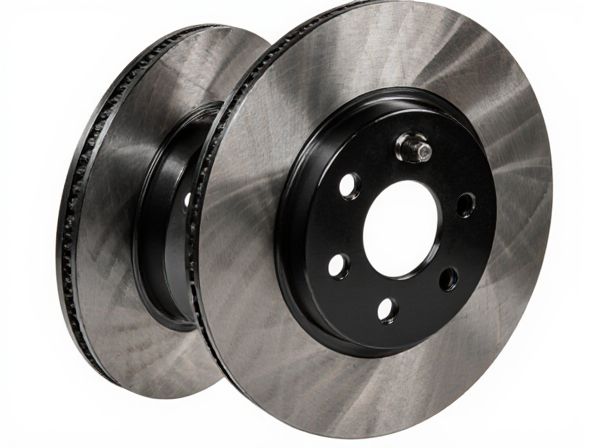
Photo illustration: Ventilated Disc vs Solid Disc
Ventilated discs offer improved heat dissipation by allowing air to flow between the disc surfaces, reducing brake fade during heavy braking. Solid discs are simpler and often more durable in low-stress applications but may overheat more quickly under intense use. Choosing the right brake disc depends on your vehicle's performance needs and driving conditions.
Table of Comparison
| Feature | Ventilated Disc Brake | Solid Disc Brake |
|---|---|---|
| Design | Two disc layers with internal ventilation channels | Single solid disc |
| Heat Dissipation | Superior cooling through airflow channels | Lower cooling efficiency, prone to overheating |
| Performance | Better braking under high stress and continuous use | Effective for regular, low-intensity braking |
| Durability | Resists warping under heavy use | More susceptible to heat damage and warping |
| Weight | Heavier due to ventilated design | Lighter and simpler construction |
| Common Use | High-performance cars, trucks, and SUVs | Economy cars and standard braking needs |
| Cost | Higher initial cost | Lower initial cost |
Introduction to Brake Discs
Brake discs are critical components in vehicle braking systems, designed to convert kinetic energy into heat through friction. Ventilated discs feature internal channels that enhance heat dissipation, reducing the risk of brake fade during intense or prolonged braking. Solid discs, typically used in lighter vehicles or front brakes, offer simplicity and cost-effectiveness but are less efficient in cooling compared to ventilated designs.
What is a Solid Disc?
A solid disc brake consists of a single, solid metal plate that rotates with the wheel and provides a surface for brake pads to clamp onto, creating friction to slow or stop the vehicle. It is typically made from cast iron or carbon composites and offers consistent braking performance under normal driving conditions. Solid discs are generally simpler in design, more durable, and cost-effective but may dissipate heat less efficiently compared to ventilated discs, making them less suitable for high-performance or heavy-duty applications.
What is a Ventilated Disc?
A ventilated disc brake features two parallel discs separated by a series of vents or vanes, designed to improve heat dissipation during braking. The airflow between these vents reduces the risk of brake fade by maintaining lower operating temperatures compared to solid discs. This design enhances overall braking performance and prolongs the lifespan of the brake components.
Key Design Differences
Ventilated discs feature internal vanes between the disc faces, enhancing heat dissipation through increased airflow, while solid discs consist of a single solid metal piece, limiting cooling capacity. The key design difference lies in the ventilated disc's dual-layer structure that reduces brake fade during heavy braking by maintaining lower temperatures compared to the solid disc. This design advantage makes ventilated discs preferred in high-performance and heavy-duty braking systems.
Heat Dissipation Comparison
Ventilated discs feature internal vanes that enhance airflow, significantly improving heat dissipation compared to solid discs. This design reduces brake fade by maintaining lower operating temperatures during repeated or prolonged braking. Consequently, ventilated discs offer superior thermal management, making them ideal for high-performance and heavy-duty applications.
Performance in Real-World Driving
Ventilated discs offer superior heat dissipation, reducing brake fade during prolonged or intense braking, which enhances overall performance in real-world driving conditions. Solid discs provide consistent braking power for everyday driving but may overheat quickly under heavy use, leading to reduced effectiveness. Choosing ventilated discs improves safety and reliability in demanding scenarios such as mountainous terrain or stop-and-go traffic.
Durability and Longevity
Ventilated discs provide enhanced heat dissipation compared to solid discs, significantly reducing the risk of brake fade and increasing overall durability. The design of ventilated discs helps maintain optimal braking performance under high-stress conditions, contributing to a longer lifespan. Solid discs, while simpler and often more cost-effective, tend to wear faster due to less efficient heat management, resulting in reduced longevity.
Cost and Maintenance Considerations
Ventilated discs generally cost more than solid discs due to their complex design aimed at improved heat dissipation and performance. Maintenance for ventilated discs often requires more frequent inspection and potential replacements because their intricate structure is more prone to wear and warping under heavy use. Solid discs offer a lower initial cost and simpler maintenance, making them a cost-effective choice for standard driving conditions with less frequent maintenance needs.
Ideal Applications for Each Disc Type
Ventilated discs excel in high-performance and heavy-duty applications such as sports cars, trucks, and vehicles frequently driven in mountainous or stop-and-go conditions due to their superior heat dissipation and reduced brake fade. Solid discs are ideal for everyday vehicles and lighter-duty applications where braking demands are moderate, offering cost-effectiveness and sufficient performance for city driving and highway cruising. Choosing between ventilated and solid discs depends on vehicle weight, driving style, and thermal management needs to ensure optimal braking efficiency and safety.
Conclusion: Choosing the Right Brake Disc
Ventilated discs offer superior heat dissipation and reduced brake fade, making them ideal for high-performance and heavy-duty vehicles, while solid discs provide reliable braking performance at a lower cost and are suitable for lighter vehicles or everyday driving. When choosing the right brake disc, consider factors such as vehicle type, driving conditions, and budget to ensure optimal safety and performance. Prioritizing ventilated discs enhances durability and braking efficiency under stress, whereas solid discs deliver consistent performance for standard driving needs.
 caratoz.com
caratoz.com